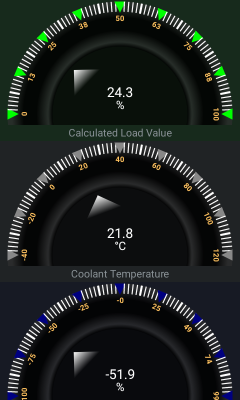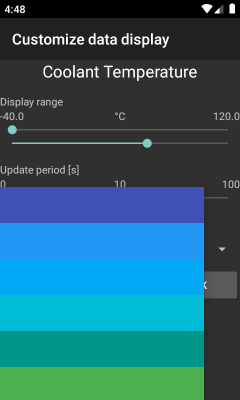-
-
Notifications
You must be signed in to change notification settings - Fork 310
Data customization
The display of OBD data items is automatically preset to:
- Data item color based on OBD PID
- Data MIN/MAX display range based on
- PID data range / resolution
- Static csv configuration (pids.csv)
- Data request update period
- Static csv configuration (pids.csv)
Since AndrOBD version V2.5.0 following display parameters of each data item can be customized/personalized at program runtime.
- Display color
- Display MIN/MAX data range
- Data request update period
Selected customization values are stored within the program preferences and re-used for further app runs.
Data display customisation can be selected by long pressing the gauge display of a single data item. The customisation dialog allows you to select the MIN/MAX display range and display color of seleted data item


Data customisation is a feature which I recommend be used by advanced AndrOBD users only, because inconsistencies in customisation data may create inconsistent output or even lead to a program crash. So, if you know what you are doing, please play with it, but don't blame it on me if you don't ;-)
Before modifying the files, please read the chapter Data model carefully.
The purpose of data customization is to allow users to:
- add new custom PIDs / data items if they are not covered yet
- use custom data conversions / scaling
- overrule existing PIDs / data items / conversions
- add new custom fault codes if they are not covered yet
- overrule existing fault codes with custom descriptions
The customization is done by loading additional configuration data files into the existing data model. These files have to be stored on your device (i.e. /sdcard/com.fr3ts0n.ecu.gui.androbd/custom/) and may be selected in the settings dialogue.
Template sample customisation files may be found here: https://github.com/fr3ts0n/AndrOBD/tree/master/customisation/templates
Please note that - once configured - the files will be loaded at every program startup. In order to run the original data model again, you will have to clear it out of the configuration by aborting the file selection process for the corresponding setting.